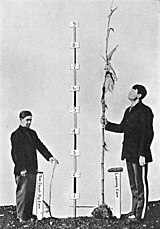
Heritability is a statistic used in the fields of breeding and genetics that estimates the degree of variation in a phenotypic trait in a population that is due to genetic variation between individuals in that population.[1] The concept of heritability can be expressed in the form of the following question: "What is the proportion of the variation in a given trait within a population that is not explained by the environment or random chance?"[2]
Other causes of measured variation in a trait are characterized as environmental factors, including observational error. In human studies of heritability these are often apportioned into factors from "shared environment" and "non-shared environment" based on whether they tend to result in persons brought up in the same household being more or less similar to persons who were not.
Heritability is estimated by comparing individual phenotypic variation among related individuals in a population, by examining the association between individual phenotype and genotype data,[3][4] or even by modeling summary-level data from genome-wide association studies (GWAS).[5] Heritability is an important concept in quantitative genetics, particularly in selective breeding and behavior genetics (for instance, twin studies). It is the source of much confusion due to the fact that its technical definition is different from its commonly-understood folk definition. Therefore, its use conveys the incorrect impression that behavioral traits are "inherited" or specifically passed down through the genes.[6] Behavioral geneticists also conduct heritability analyses based on the assumption that genes and environments contribute in a separate, additive manner to behavioral traits.[7]
- ^ Wray N, Visscher P (2008). "Estimating Trait Heritability". Nature Education. 1 (1): 29. Archived from the original on 2 August 2015. Retrieved 24 July 2015.
- ^ Gazzaniga MS, Heatherton TF, Halpern DF (February 2015). Psychological science (5th ed.). New York. ISBN 978-0-393-26313-8. OCLC 908409996.
{{cite book}}: CS1 maint: location missing publisher (link) - ^ Yang J, Lee SH, Goddard ME, Visscher PM (January 2011). "GCTA: a tool for genome-wide complex trait analysis". American Journal of Human Genetics. 88 (1): 76–82. doi:10.1016/j.ajhg.2010.11.011. PMC 3014363. PMID 21167468.
- ^ Cite error: The named reference
:0was invoked but never defined (see the help page). - ^ Cite error: The named reference
:1was invoked but never defined (see the help page). - ^ Stoltenberg SF (June 1997). "Coming to terms with heritability". Genetica. 99 (2–3): 89–96. doi:10.1007/BF02259512. hdl:2027.42/42804. PMID 9463077. S2CID 18212219. Archived from the original on 2020-12-02. Retrieved 2020-12-24.
- ^ Wahlsten D (1994). "The intelligence of heritability" (PDF). Canadian Psychology. 35 (3): 244–260. doi:10.1037/0708-5591.35.3.244. ISSN 1878-7304. Archived (PDF) from the original on 2018-10-24. Retrieved 2019-12-05.